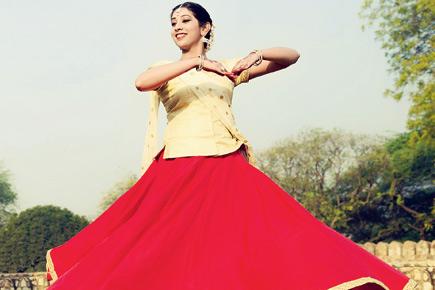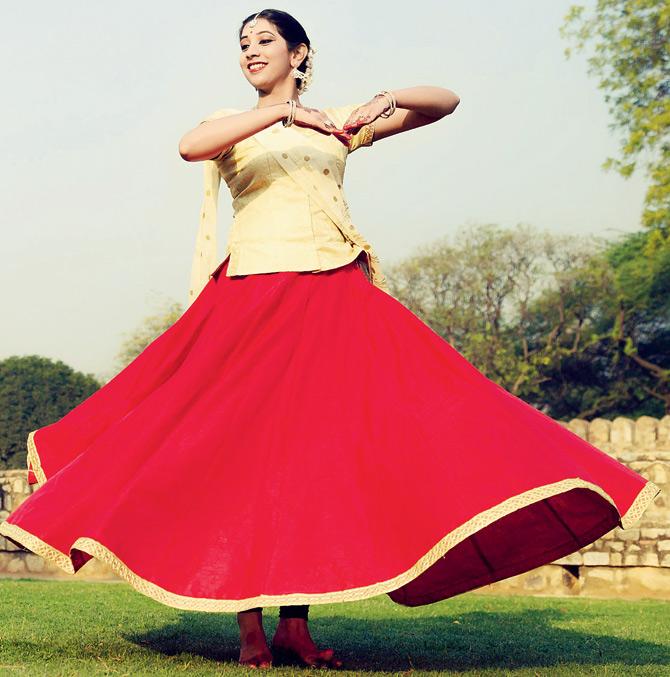An interactive workshop will explore Kathak's influences beyond the stereotype associated with the dance form

Siddhi Goel
![]() A dancer dressed in a floor length Anarkali wowing the audience with the famed chakkars that are associated with kathak tends to be the first image that comes to mind when you think of the form. The image of a Bollywood-style mujra comes a close second. "While there is nothing incorrect with that image as kathak was responding to its time in every era. There is a lot more to it than what people know about," asserts Delhi–based Siddhi Goel, who will conduct an interactive workshop, titled The Kathak Nayika: Devotee, Courtesan, or Vamp? in the city, this Friday. This 45-minute workshop will explore the lesser-known heroines of the dance form, across history, and will recognise their role in expanding the richness of dance and musical heritage.
A dancer dressed in a floor length Anarkali wowing the audience with the famed chakkars that are associated with kathak tends to be the first image that comes to mind when you think of the form. The image of a Bollywood-style mujra comes a close second. "While there is nothing incorrect with that image as kathak was responding to its time in every era. There is a lot more to it than what people know about," asserts Delhi–based Siddhi Goel, who will conduct an interactive workshop, titled The Kathak Nayika: Devotee, Courtesan, or Vamp? in the city, this Friday. This 45-minute workshop will explore the lesser-known heroines of the dance form, across history, and will recognise their role in expanding the richness of dance and musical heritage.
ADVERTISEMENT

Siddhi Goel
"Many people don't acknowledge Kathak as a Classical form as it does not draw as much from the Natya Shastra as other Classical forms. While it gets its mudras and stage aesthetics from there, it draws from various other influences, like the Chakkars came from the dervishes and the Thumris came from medieval poetry, particularly in the time of Nawab Wajid Ali Shah, the founders of the Lucknow gharana wrote many Thumris that are performed even today.
The Muhghal courts too influenced the costumes. Earlier it used to be Lehengas for the women and dhotis for the men. The topis and the anarkalis were influenced by the Islamic culture in the Mughal era," adds 22-year old Goel whose passion for the dance is evident in her voice, over the phone lines from the national capital.
According to Goel, while the form has largely been associated with courtesans there are other Nayikas or heroines who played a large role in developing Kathak.
"I will talk about the rasas of bhakti and shringar which are usually overlooked. I will look at the styles and contributions of Kashmiri Sufi saint Lal Ded, and Akka Mahadevi who was one of the early female poets of the Kannada language and a prominent personality in the Veerashaiva Bhakti movement of the 12th century. Lal Ded for example is not as popular as Nayika's like Meera though they were contemporaries. There are many talks and performances about Radha too," says Goel who is currently studying as a disciple of Pandit Jai Kishan Maharaj, the elder son of Padma Vibhushan Pandit Birju Maharaj along with pursuing her Masters in Arts and Aesthetics from Jawaharlal Nehru University in New Delhi.
The workshop will also try and break myths associated with courtesans. "We used the term vamp in the title of the workshop because many people associated a negative connotation to the word courtesan or tawaif. They were highly intelligent women who wrote great poetry and were known to have the ability to make intelligent conversation," shares Goel who spent a year researching the subject. "In the Nehruvian era, in the early 20th century to Post Independence, there was an effort to 'clean up' these dance forms. People weren't keen to associate Kathak with courtesans and Bharatanatyam with Devdasis. Many scholars wrote books on this subject. Pallavi Chakravarti's book, Bells of Change influenced me. Dance schools do not pay much attention to history, and we tend to ignore subaltern voices in our learning of history," she sums up.
 Subscribe today by clicking the link and stay updated with the latest news!" Click here!
Subscribe today by clicking the link and stay updated with the latest news!" Click here!






